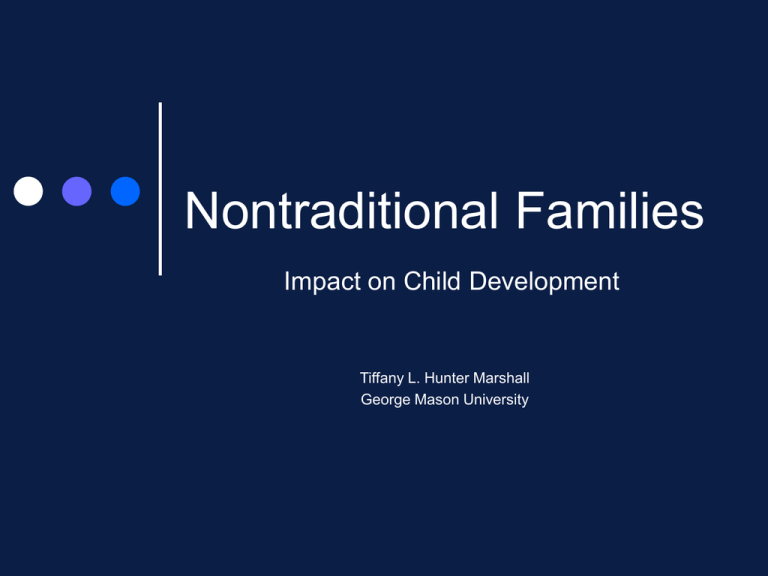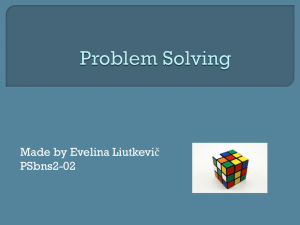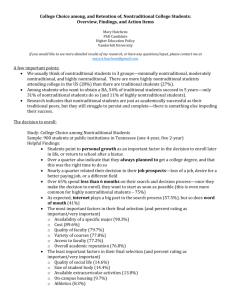Nontraditional Families - Tiffany L. Hunter Marshall
advertisement

Nontraditional Families Impact on Child Development Tiffany L. Hunter Marshall George Mason University The Facts “Of the 74.6 million children younger than 18 in 2011, most (69 percent) lived with two parents, while another 27 percent lived with one parent and 4 percent with no parents. Of those children who lived with two parents, 92 percent lived with two biological or two adoptive parents.” America’s Families and Living Arrangements, 2011; US Census Bureau ….hence, a LARGE portion of the US’s children are members of nontraditional or “alternative” families. http://myfunctionalfamily.com/wp-content/uploads/2010/09/entire-jolie-pitt-family-before-babies2.jpg Types of Nontraditional Families Blended Same-sex Parents Cohabitating, Unmarried Parents Single Parents Adoptive Parents Foster Parents Grandparents as Caregivers …………….. The Breakdown Controversial topic: Youths in two-biological-parent “intact” families: • • commit the fewest kinds of antisocial behaviors display fewer cognitive, emotional, and social problems compared to children of all other alternative family types Current research says there’s apparent disadvantages for child development in each type of alternative family… But there are also protective and resiliency factors that may benefit children of these families in the long run. We Will Explore… Blended Families Divorced/Single Parents Adoptive Parents Same-sex Parents http://moniquehillen.com/wp-content/uploads/2010/09/blended_family_-_solo_1_.jpg Blended Families Criminology Research: “broken homes” elevated risk for delinquent behavior Patterson & Dishion’s (1985) Stages of Delinquency • 1. childhood: poor parental monitoring and family management lead to antisocial behavior, reduced academic achievement, and maladaptive social development. • 2. adolescence: continued inadequate parental monitoring and control leads to school failure and peer rejection that place adolescents at risk for pressure and influence from deviant peer groups http://www.cartoonstock.com/newscartoons/cartoonists/rro/lowres/rron666l.jpg (Apel & Kaukinen, 2008) Divorced/Single Parent Disadvantages: Economic Hardship Eating Patterns in Adolescence Emotional/Cognitive Reactions to Transitions • Sense of Isolation • Confusion http://www.singlemomfinance.com/wp-content/uploads/2011/07/singlemother.jpg Parental Involvement • fostering emotional attachment • Setting/maintaining rules • Contact lessened? • Tough time for parents too More behavioral, internalizing, social, and academic problems (Kelly & Emery, 2003;Stewart & Menning, 2009) http://images.meredith.com/ab/images/2007/09/p_101068735.jpg Adoptive Parents Parental Investment Theories Lack of blood ties Kin selection Environment of Evolutionary Adaptedness (EEA) Socioeconomic issues Findings: remarkably similar to 2-parent biological families Disadvantages Parental problems- “perfect parent” pressures Social stigma http://babygearworld.com/wp-content/uploads/2010/09/Supporting-the Lack early bonding experience Adopted-Family-Member-Financially.jpg Multiple transitions worse academic, behavioral, and emotional outcomes than 2-parent bio. families Advantages (compared to other alternative families) educational achievement employment success Asset accumulation (Hamilton, Cheng, & Powell, 2007) http://cdn.sheknows.com/articles/couple-and-adopted-daughter.jpg Same-Sex Parents Disadvantages Burden of home life- need to succeed Teasing/ rejection by peers/society Feeling need to “come out” Retrospective (Adult) Reports: http://www.babble.com/CS/blogs/strollerderby/2008/12/16-22/samesex_1.jpg • Many schools reinforced institutional heterosexism pressure to minimize challenges, depression, anger, relationship issues within family, acting out Advantages Children may be: • • • • Less gender-typed Less rigid about sexuality More able to express feelings More empathetic/tolerance of diversity Others: • Openness and Realism in Parenting-->Coping Strategies • Social Support (Goldberg, 2010) http://afth.files.wordpress.com/2009/06/gay_parents.jpg?w=300&h=216 The Reality is… “While there is general agreement that children from nontraditional family structures tend to show poorer social, psychological, and academic adjustment when compared with children from two-biological-parent families, there is less clarity about the factors that may contribute to those poorer outcomes, or factors that may act as buffers against them… Quality of parenting and relationships was strongly associated with children's social, psychological and academic adjustment in both traditional and nontraditional families.” (Bronstein, Clauson, Stoll, & Abrams, 1993) Counseling Implications Key factors in working with children of this population: Ecological/ Systems Perspective Legal issues affecting parental investment Sensitivity and Empathy Solutions/ Interventions Involving families in counseling services Prevention services for at-risk populations (academic, behavioral, psychological problems) Advocacy against discrimination against nontraditional families/their children (in schools and in community) Support groups for students (i.e. in transition, bullied, pride, etc…) References Apel, R. & Kaukinen, C. (2008). On the relationship between family structure and antisocial behavior: Parental cohabitation and blended households. Criminology, 46(1), 35-70. Bronstein, P., Clauson, J., Stoll, M. F., & Abrams, C. L. (1993). Parenting behavior and children's social, psychological, and academic adjustment in diverse family structures. Family Relations, 42 (3), 268-276. Carlson, M. J. & Corcoran, M. E. (2001). Family structure and children's behavioral and cognitive outcomes. Journal of Marriage and Family, 63(3), 779.792. Deater-Deckard, K., Dunn, J., & Lussier, G. (2002). Sibling relationships and socialemotional adjustment in different family contexts. Social Development, 11(4), 571-590. Gennetian, L. A. (2005). One or two parents? Half or step siblings? The effect of family structure on young children's achievement. Journal of Population Economics, 18(3), 415-436. Goldberg, A. E. (2010). Young adults and adults with lesbian and gay parents speak out. Lesbian and gay parents and their children: Research on the family life cycle. (157-175). Washington, DC, US: American Psychological Association. Hamilton, L., Cheng, S., & Powell, B. (2007). Adoptive parents, adaptive parents: Evaluating the importance of biological ties for parental investment. American Sociological Review, 72(1), 95-116. Kelly, J. B. & Emery, R. E. (2003). Children's adjustment following divorce: Risk and resilience perspectives. Family Relations, 52(4), 352-362. Kierkus, C. A. & Hewitt, J. D. (2009). The contextual nature of the family structure/delinquency relationship. Journal of Criminal Justice, 37, 123-132. doi:10.1016/j.jcrimjus.2009.02.008 Ono, H. & Sanders, J. (2010). Diverse family types and out-of-school learning time of young school-age children, Family Relations, 59, 506 – 519. doi:10.1111/j.17413729.2010.00619.x Pelka, S. (2010). Observing multiple mothering: a case study of childrearing in a U.S. lesbian-led family. Journal of the Society for Psychological Anthropology, 38(4), 422-440. doi: 10.1111/j.1548-1352.2010.01159.x. Stewart, S. D. (2010). The characteristics and well-being of Adopted Stepchildren. Family Relations, 59, 558 – 571. doi:10.1111/j.1741-3729.2010.00623.x Stewart, S. D. & Menning, C. L. (2009). Family structure, nonresident father involvement, and adolescent eating patterns. Journal of Adolescent Health, 45, 193-201. doi:10.1016/j.jadohealth.2009.01.005






![2[<---Click on link] - socialstudiesguy.com](http://s2.studylib.net/store/data/005453708_1-895a35768b91cdab66a77df6b59f9930-300x300.png)


